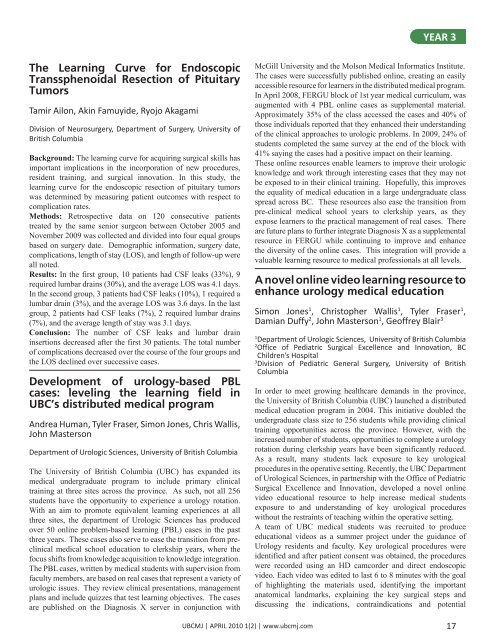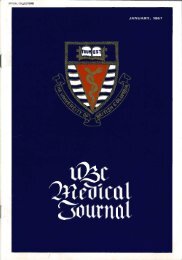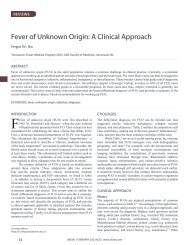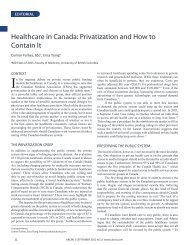Download full PDF - UBC Medical Journal
Download full PDF - UBC Medical Journal
Download full PDF - UBC Medical Journal
You also want an ePaper? Increase the reach of your titles
YUMPU automatically turns print PDFs into web optimized ePapers that Google loves.
YEAR 3<br />
The Learning Curve for Endoscopic<br />
Transsphenoidal Resection of Pituitary<br />
Tumors<br />
Tamir Ailon, Akin Famuyide, Ryojo Akagami<br />
Division of Neurosurgery, Department of Surgery, University of<br />
British Columbia<br />
Background: The learning curve for acquiring surgical skills has<br />
important implications in the incorporation of new procedures,<br />
resident training, and surgical innovation. In this study, the<br />
learning curve for the endoscopic resection of pituitary tumors<br />
was determined by measuring patient outcomes with respect to<br />
complication rates.<br />
Methods: Retrospective data on 120 consecutive patients<br />
treated by the same senior surgeon between October 2005 and<br />
November 2009 was collected and divided into four equal groups<br />
based on surgery date. Demographic information, surgery date,<br />
complications, length of stay (LOS), and length of follow-up were<br />
all noted.<br />
Results: In the first group, 10 patients had CSF leaks (33%), 9<br />
required lumbar drains (30%), and the average LOS was 4.1 days.<br />
In the second group, 3 patients had CSF leaks (10%), 1 required a<br />
lumbar drain (3%), and the average LOS was 3.6 days. In the last<br />
group, 2 patients had CSF leaks (7%), 2 required lumbar drains<br />
(7%), and the average length of stay was 3.1 days.<br />
Conclusion: The number of CSF leaks and lumbar drain<br />
insertions decreased after the first 30 patients. The total number<br />
of complications decreased over the course of the four groups and<br />
the LOS declined over successive cases.<br />
Development of urology-based PBL<br />
cases: leveling the learning field in<br />
<strong>UBC</strong>’s distributed medical program<br />
Andrea Human, Tyler Fraser, Simon Jones, Chris Wallis,<br />
John Masterson<br />
Department of Urologic Sciences, University of British Columbia<br />
The University of British Columbia (<strong>UBC</strong>) has expanded its<br />
medical undergraduate program to include primary clinical<br />
training at three sites across the province. As such, not all 256<br />
students have the opportunity to experience a urology rotation.<br />
With an aim to promote equivalent learning experiences at all<br />
three sites, the department of Urologic Sciences has produced<br />
over 50 online problem-based learning (PBL) cases in the past<br />
three years. These cases also serve to ease the transition from preclinical<br />
medical school education to clerkship years, where the<br />
focus shifts from knowledge acquisition to knowledge integration.<br />
The PBL cases, written by medical students with supervision from<br />
faculty members, are based on real cases that represent a variety of<br />
urologic issues. They review clinical presentations, management<br />
plans and include quizzes that test learning objectives. The cases<br />
are published on the Diagnosis X server in conjunction with<br />
McGill University and the Molson <strong>Medical</strong> Informatics Institute.<br />
The cases were success<strong>full</strong>y published online, creating an easily<br />
accessible resource for learners in the distributed medical program.<br />
In April 2008, FERGU block of 1st year medical curriculum, was<br />
augmented with 4 PBL online cases as supplemental material.<br />
Approximately 35% of the class accessed the cases and 40% of<br />
those individuals reported that they enhanced their understanding<br />
of the clinical approaches to urologic problems. In 2009, 24% of<br />
students completed the same survey at the end of the block with<br />
41% saying the cases had a positive impact on their learning.<br />
These online resources enable learners to improve their urologic<br />
knowledge and work through interesting cases that they may not<br />
be exposed to in their clinical training. Hope<strong>full</strong>y, this improves<br />
the equality of medical education in a large undergraduate class<br />
spread across BC. These resources also ease the transition from<br />
pre-clinical medical school years to clerkship years, as they<br />
expose learners to the practical management of real cases. There<br />
are future plans to further integrate Diagnosis X as a supplemental<br />
resource in FERGU while continuing to improve and enhance<br />
the diversity of the online cases. This integration will provide a<br />
valuable learning resource to medical professionals at all levels.<br />
A novel online video learning resource to<br />
enhance urology medical education<br />
Simon Jones 1 , Christopher Wallis 1 , Tyler Fraser 1 ,<br />
Damian Duffy 2 , John Masterson 1 , Geoffrey Blair 3<br />
1<br />
Department of Urologic Sciences, University of British Columbia<br />
2<br />
Office of Pediatric Surgical Excellence and Innovation, BC<br />
Children’s Hospital<br />
3<br />
Division of Pediatric General Surgery, University of British<br />
Columbia<br />
In order to meet growing healthcare demands in the province,<br />
the University of British Columbia (<strong>UBC</strong>) launched a distributed<br />
medical education program in 2004. This initiative doubled the<br />
undergraduate class size to 256 students while providing clinical<br />
training opportunities across the province. However, with the<br />
increased number of students, opportunities to complete a urology<br />
rotation during clerkship years have been significantly reduced.<br />
As a result, many students lack exposure to key urological<br />
procedures in the operative setting. Recently, the <strong>UBC</strong> Department<br />
of Urological Sciences, in partnership with the Office of Pediatric<br />
Surgical Excellence and Innovation, developed a novel online<br />
video educational resource to help increase medical students<br />
exposure to and understanding of key urological procedures<br />
without the restraints of teaching within the operative setting.<br />
A team of <strong>UBC</strong> medical students was recruited to produce<br />
educational videos as a summer project under the guidance of<br />
Urology residents and faculty. Key urological procedures were<br />
identified and after patient consent was obtained, the procedures<br />
were recorded using an HD camcorder and direct endoscopic<br />
video. Each video was edited to last 6 to 8 minutes with the goal<br />
of highlighting the materials used, identifying the important<br />
anatomical landmarks, explaining the key surgical steps and<br />
discussing the indications, contraindications and potential<br />
<strong>UBC</strong>MJ | APRIL 2010 1(2) | www.ubcmj.com 17










